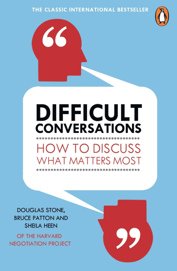
- By Codurance Insights
- ·
- Posted 07 Apr 2025
The CTO Playbook for Retail Transformation: Building for Agility, Data, and Customer Experience
In today’s retail environment, customer experience is the battleground—and technology is at the heart of it.
 Since its publication in 1999, Difficult Conversations: How to Discuss What Matters Most (Douglas Stone, Bruce Patton, and Sheila Heen) has become the book on how to have those conversations are uncomfortable, hard or challenging.
Since its publication in 1999, Difficult Conversations: How to Discuss What Matters Most (Douglas Stone, Bruce Patton, and Sheila Heen) has become the book on how to have those conversations are uncomfortable, hard or challenging.
This book is based on fifteen years of research at the Harvard Negotiation Project. The latest edition has been updated to include the chapter: "Answers to Ten Questions People Ask".
Difficult conversations is a book that anyone at any stage of their life could read, this is not just a book about leadership or management, it goes further; into the relationships that we have in every part of our lives.
Relationships require difficult conversations, be it with your children, your boss, your parents and even yourself.
Difficult conversations can create a variety of feelings in us and challenging both our own ideas and other peoples does make us uncomfortable. For some, just the thought of a possible disagreement can make them put off the conversation.
So, in that case, what should we do?
The book answers this by taking you through the stages that you need to address. Split into three main parts, it covers:
At the end of the book, the authors look at answering key questions that readers often have.
Being well prepared for a difficult conversation means that you are more likely to get a positive result. Unfortunately, most of us aren't prepared.
To put is simply, the if we lack understanding of ourselves, then we can't start to understand others.
The authors also argue that conflicts take place because people are not capable of switching to a learning instance. Instead, our default approach is to hold on to only one-side of the story, often our own.
The Difficult Conversations approach is through use cases of people that have been there and shared their history so that we can learn from and analyse what could have been better.
The first chapter talks about the three conversations that is playing around when we are talking with someone. In this case the use case shown came from a presentation that didn't go well, simply due an error in the slides presented.
The authors then use that as a way to introduce us to the three types of conversations.
The what happened conversation goes in a direction of "who is right", "assuming that they meant it" and blame - Chapters from 2 through 4 explore the types of conversations.
The bottom line from the book on whatever type of conversation is to shift the difficult conversation into a learning conversation.
Difficult conversations usually involve disagreements - this is classic behaviour to start a difficult conversation. In this section the authors presented a dialogue between two parties that work together to deliver a presentation.
It turns out that the slides for the presentation had an error on it, which was the root cause of what is the starting point to “difficult conversations”.
Difficult conversations bring questions about our own feelings, should I share them? What about the other person's feelings?
This is our internal conversation, what our feelings have to say and what to do to deal with them.
In the revised versions, the authors have added in a new chapter covering the ten questions that they are most often asked. These included a few questions that we had thought, whilst we read the book.
To give you a feel of the book and to encourage you to also read it, I will touch on three of the questions that I found the most interesting.
Fundamentally the authors agree with this statement.
However, they do argue that regardless of culture, we all have that one internal voice. They recommend listening to the internal voice and that shifting from a difficult conversation to a learning conversation can be used as a tool regardless of your cultural background.
In a post COVID19 world this is an especially relevant question.
The authors argue that in a digital world, our main form of communication has shifted to email and because of this, extra case should be taken when reading and writing.
When reading:
When writing:
The authors also elaborate on what to do when the conversation is by phone.
Most self-help / improvement books of recent years tend to be prescriptive.
Do this, stop doing that and your life will be better.
Difficult Conversations breaks this mould.
The book focuses on three key elements:
The content is well both well researched and written, and leans heavily on ideas that will be familiar to anyone who is familiar with professional therapy.
For example; understanding how your identity, characterised here as your identity conversation, can make it difficult to have a calm and effective conversation.
More importantly, it talks about how to overcome difficult tendencies that are often deeply entrenched behaviours, making them very hard to overcome. The same is true about how the book helps you break down the three conversations that can exist and provide good, and more importantly, practical tools for identifying the type of conversation being had and how to make those conversations as effective as possible.
One of our favourite tools is the concept of contribution, which can help everyone understand how we contributed to a problem without allocating blame. A much more constructive basis to understand how someone can move forward and avoid the same problems in the future. This is something we have found useful in our day to day life.
Difficult Conversations is a must read for anyone that has to work with people (so more less everyone). We have seen its benefits, not only in our professional lives, but in our personal ones.
It’s authentic. It doesn't promise a magical solution to all your problems, but it is a tool that can help you on your way to being a master of the difficult conversations we all must have.
Difficult Conversations is available from all normal book outlets and is also available as either a kindle edition or audio book.
ISBN-10: 014027782X
ISBN-13: 978-0140277821
Stone & Heen website, founded by Douglas Stone & Sheila Heen has further resources.
Further reading

In today’s retail environment, customer experience is the battleground—and technology is at the heart of it.

For fast-growing businesses, scaling a software team isn’t just about hiring more developers — it’s about doing so in a way that maintains quality,..

As a newly appointed CTO or Engineering Leader, the first 90 days in the role, company or project is a critical time; get it right in this quarter..
Join our newsletter for expert tips and inspirational case studies
Join our newsletter for expert tips and inspirational case studies